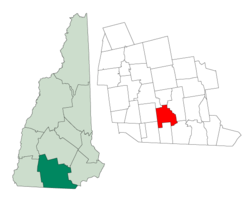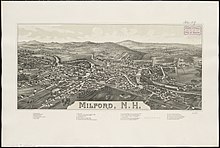world.wikisort.org - USA
Milford is a town in Hillsborough County, New Hampshire, United States, on the Souhegan River. The population was 16,131 at the 2020 census,[3] up from 15,115 at the 2010 census.[4] It is the retail and manufacturing center of a multi-town area known informally as the Souhegan Valley.
Milford, New Hampshire | |
|---|---|
Town | |
 The center oval and town hall | |
 Seal | |
 Location in Hillsborough County, New Hampshire | |
| Coordinates: 42°50′07″N 71°38′56″W | |
| Country | United States |
| State | New Hampshire |
| County | Hillsborough |
| Incorporated | 1794 |
| Government | |
| • Board of Selectmen | Paul Dargie, Chair Tim Finan, Vice Chair Laura Dudziak Gary Daniels Dave Freel[1] |
| • Town Administrator | John Shannon |
| Area | |
| • Total | 25.47 sq mi (65.96 km2) |
| • Land | 25.41 sq mi (65.82 km2) |
| • Water | 0.05 sq mi (0.14 km2) 0.22% |
| Elevation | 259 ft (79 m) |
| Population (2020)[3] | |
| • Total | 16,131 |
| • Density | 635/sq mi (245.1/km2) |
| Time zone | UTC-5 (Eastern) |
| • Summer (DST) | UTC-4 (Eastern) |
| ZIP code | 03055 |
| Area code | 603 |
| FIPS code | 33-48020 |
| GNIS feature ID | 0873666 |
| Website | www |
The town center, where 9,212 people lived at the 2020 census, is defined as the Milford census-designated place (CDP), and is located at the junction of New Hampshire routes 13 and 101A.
History

Milford separated from neighboring Amherst in 1794. Like most towns named Milford in the United States, its name comes from the fact that it grew around a mill built on a ford—in this case on the Souhegan River.[5]
Milford was once home to numerous granite quarries, which produced a stone that was used, among other things, to make the pillars for the U.S. Treasury in Washington, D.C.—pillars that can be seen on the back of the American $10 bill.[6][7] Its nickname remains "The Granite Town", although only one small quarry is in operation as of 2017.
Like many New England riverside towns, Milford developed several thriving textile mills in the 19th century. That industry left New England by World War II, but Milford remains the commercial and retail center for surrounding towns. Major employers included casting company Hitchiner Manufacturing Co.,[8] a metal cable manufacturer, Hendrix Wire and Cable Inc.,[9] and a contract manufacturing solutions company, Cirtronics Corporation.[10] In 2018, local firm Alene Candles became one of the first companies in the state to implement a "conscious leadership" program in a manufacturing production setting.[11]
Milford is home to the Milford State Fish Hatchery.[12] The town also holds the Souhegan Valley Boys & Girls Club, built on the former home of the now-bankrupt private theater American Stage Festival.
Milford was a stop on the Underground Railroad for escaped slaves.[citation needed] It was also the home of Harriet E. Wilson, who published the semi-autobiographical novel Our Nig: Or, Sketches in the Life of a Free Black in 1859, making it the first novel by an African-American woman published in the country.
Officially designated "Union Square", the Milford Oval is neither square nor oval in shape, but rather triangular. The "square" name in American parlance denotes a town common irrespective of geometry, and the "oval" name dates from the 19th century, when it was oval in shape. The Oval is the town center, with the Pillsbury Bandstand as its centerpiece and the Souhegan River as the backdrop. The Oval is formed by a modified traffic rotary in which State Highways 13 and 101A intersect, with northbound 13 and eastbound 101A passing straight through and crossing each other at a right angle with a stop sign for traffic on Route 13. For many years, the Oval's traffic flow was treated as a series of three individual intersections of three one-way streets, resulting in the unusual arrangement whereby vehicles entering the Oval had right-of-way over vehicles turning left to continue through the Oval. This treatment was reversed in the 1980s to conform with traffic rotary norms whereby vehicles already in the Oval have right-of-way over vehicles entering the Oval.
- Centennial Park
- William Peabody House
- Union Square c. 1905
- Union Square in 2006
- Stone Bridge c. 1905
- Elm Street c. 1915
- Centennial High School c. 1905
Geography
According to the United States Census Bureau, the town has a total area of 25.5 square miles (66.0 km2), of which 25.4 square miles (65.8 km2) are land and 0.04 square miles (0.1 km2) are water, comprising 0.22% of the town.[2] Milford is drained by the Souhegan River, an east-flowing tributary of the Merrimack River. The southwest part of town is drained by Mitchell Brook and Spaulding Brook, which flow south into Brookline and are part of the Nashua River watershed, another tributary of the Merrimack. The town's highest point is near its western border, on the summit of Boynton Hill, at 814 feet (248 m) above sea level.
Adjacent municipalities
- Lyndeborough, New Hampshire (north)
- Mont Vernon, New Hampshire (north)
- Amherst, New Hampshire (east)
- Hollis, New Hampshire (southeast)
- Brookline, New Hampshire (south)
- Mason, New Hampshire (southwest)
- Wilton, New Hampshire (west)
Demographics
| Historical population | |||
|---|---|---|---|
| Census | Pop. | %± | |
| 1800 | 939 | — | |
| 1810 | 1,117 | 19.0% | |
| 1820 | 1,243 | 11.3% | |
| 1830 | 1,303 | 4.8% | |
| 1840 | 1,455 | 11.7% | |
| 1850 | 2,159 | 48.4% | |
| 1860 | 2,223 | 3.0% | |
| 1870 | 2,606 | 17.2% | |
| 1880 | 2,308 | −11.4% | |
| 1890 | 3,014 | 30.6% | |
| 1900 | 3,739 | 24.1% | |
| 1910 | 3,939 | 5.3% | |
| 1920 | 3,783 | −4.0% | |
| 1930 | 4,068 | 7.5% | |
| 1940 | 3,927 | −3.5% | |
| 1950 | 4,159 | 5.9% | |
| 1960 | 4,863 | 16.9% | |
| 1970 | 6,622 | 36.2% | |
| 1980 | 8,685 | 31.2% | |
| 1990 | 11,795 | 35.8% | |
| 2000 | 13,535 | 14.8% | |
| 2010 | 15,115 | 11.7% | |
| 2020 | 16,131 | 6.7% | |
| U.S. Decennial Census[3][13] | |||
As of the census of 2010, there were 15,115 people, 5,929 households, and 4,004 families residing in the town. There were 6,295 housing units, of which 366, or 5.8%, were vacant. The racial makeup of the town was 94.8% white, 1.3% African American, 0.2% Native American, 1.3% Asian, 0.01% Native Hawaiian or Pacific Islander, 0.6% some other race, and 1.7% from two or more races. 2.2% of the population were Hispanic or Latino of any race.[14]
Of the 5,929 households, 35.7% had children under the age of 18 living with them, 52.0% were headed by married couples living together, 10.5% had a female householder with no husband present, and 32.5% were non-families. 25.3% of all households were made up of individuals, and 9.4% were someone living alone who was 65 years of age or older. The average household size was 2.53, and the average family size was 3.04.[14]
In the town, 25.0% of the population was under the age of 18, 7.8% was from 18 to 24, 27.0% from 25 to 44, 28.3% from 45 to 64, and 11.9% were 65 years of age or older. The median age was 39.0 years. For every 100 females, there were 95.8 males. For every 100 females aged 18 and over, there were 93.3 males.[14]
For the period 2011–2015, the estimated median annual income for a household was $64,576, and the median income for a family was $80,241. Male full-time workers had a median income of $55,313 versus $38,792 for females. The per capita income for the town was $32,918. 5.8% of the population and 3.7% of families were below the poverty line. 8.2% of the population under the age of 18 and 2.7% of those 65 or older were living in poverty.[15]
Education

The Milford School District operates Jacques Memorial School (K-1), Heron Pond Elementary School (2-5), Milford Middle School (6-8), and Milford High School & Applied Technology Center (9-12).[16]
Culture
The town is known for its "Pumpkin Festival", which is normally held in early October.[17] It is held over a three-day weekend (Friday-Sunday) and attracts more than 35,000 people. The festival has many attractions including food vendors, music stages, craft fair, carved pumpkin lighting, a haunted trail, a beer and wine tasting and a fireworks display around the Oval.
Notable people
- Linda Kasabian (born 1949), former Manson Family member who participated in the Helter Skelter murders[18]
- John McLane (February 27, 1852 – April 13, 1911), 50th governor of New Hampshire, from 1905 to 1907
- Abby Hutchinson Patton (1829–1892), 19th-century singer, poet
- George A. Ramsdell (1834–1900), 46th governor of New Hampshire
- Harriet E. Wilson (1825–1900), considered the first female African-American novelist, as well as the first African American of any gender to publish a novel on the North American continent
See also
- New Hampshire Historical Marker No. 133: Captain Josiah Crosby (1730–1793) Lieutenant Thompson Maxwell (1742–1832)
- New Hampshire Historical Marker No. 268: Bernice Blake Perry (1905–1996)
References
- "Elected Officials | Milford NH".
- "2021 U.S. Gazetteer Files – New Hampshire". United States Census Bureau. Retrieved December 9, 2021.
- "Milford town, Hillsborough County, New Hampshire: 2020 DEC Redistricting Data (PL 94-171)". U.S. Census Bureau. Retrieved December 9, 2021.
- United States Census Bureau, U.S. Census website, 2010 Census figures. Retrieved March 23, 2011.
- Coolidge, Austin J.; John B. Mansfield (1859). A History and Description of New England. Boston, Massachusetts: A.J. Coolidge. pp. 580.
coolidge mansfield history description new england 1859.
- "Milford granite used for treasury building column". Milford Cabinet, April 26, 2012
- Milford Cabinet: "Not carved in stone" Feb. 2, 2017
- Cote, Mike. "Mike Cote's Business Editor's Notebook: Bringing high-end training to the workplace". Union Leader. Retrieved July 17, 2018.
- Seiler, Paul Steven (2013). "Hendrix Covered Conductor Manual" (PDF). Western Power. p. 7.
- Veasey, Michelle (May 10, 2017). "Cirtronics Wins Award for Corporate Social Responsibility Practices". MassTLC - Mass Technology Leadership Council. Retrieved July 17, 2018.
- Houghton, Kimberly (July 15, 2018). "Milford candle company embraces conscious leadership". Union Leader. Retrieved July 17, 2018.
- "New Hampshire Wildlife Management Areas". New Hampshire Fish and Game Department. Retrieved July 17, 2018.
- "Census of Population and Housing". Census.gov. Retrieved June 4, 2016.
- "Profile of General Population and Housing Characteristics: 2010 Census Summary File 1 (DP-1): Milford town, Hillsborough County, New Hampshire". American Factfinder. U.S. Census Bureau. Archived from the original on February 13, 2020. Retrieved November 2, 2017.
- "Selected Economic Characteristics: 2011-2015 American Community Survey 5-Year Estimates (DP03): Milford town, Hillsborough County, New Hampshire". American Factfinder. U.S. Census Bureau. Archived from the original on February 13, 2020. Retrieved November 2, 2017.
- "Home". Milford School District. Retrieved 2022-04-24. - Grade breakdown from National Center for Education Statistics
- "Milford Pumpkin Festival 2015". Milford Pumpkin Festival.
- "Linda Kasabian biography". Bio.True Story. Retrieved December 14, 2013.
External links
- Official website
- Wadleigh Memorial Library
- Milford History Online
- Milford Historical Society
- New Hampshire Economic and Labor Market Information Bureau Community Profile
Другой контент может иметь иную лицензию. Перед использованием материалов сайта WikiSort.org внимательно изучите правила лицензирования конкретных элементов наполнения сайта.
WikiSort.org - проект по пересортировке и дополнению контента Википедии







